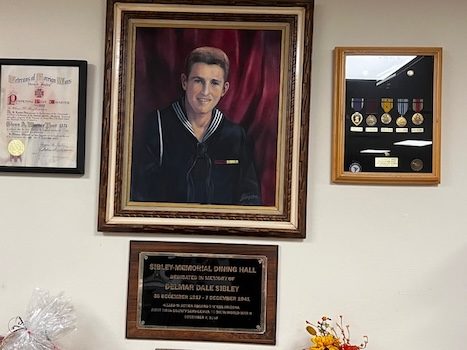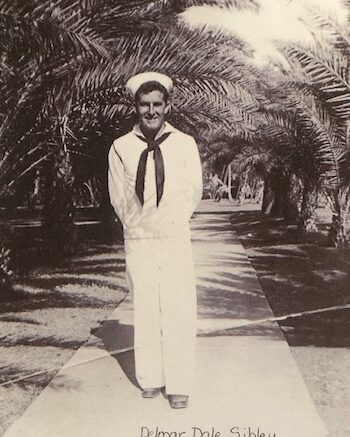By Jim Raftis Sr. —
On Pearl Harbor Remembrance Day, Saturday, Dec. 7, at 12:55 p.m., the Owego Seaman First Class Delmar Dale Sibley Memorial Hall, located inside VFW Post 1371 on Main Street in Owego, provides a significant space to honor not only Sibley, Owego/Tioga County’s first World War II casualty, but also the sacrifice of all who served and survived. His portrait and service medals, displayed on the front wall, serve as a reminder of his dedication and ultimate sacrifice. The hall also memorializes the four others who survived other Pacific battles but have since passed.
Sibley became an indelible part of history on Dec. 7, 1941, when he tragically lost his life aboard the USS Arizona. Born on Dec. 30, 1917, in Mount Vernon, South Dakota, Delmar spent his formative years amidst the majestic Black Hills near Rapid City. Before answering the call to serve his nation, he contributed to civilian conservation efforts, notably helping construct roads to the iconic Mount Rushmore, carving the faces of four American presidents into the landscape.
At the age of 19, seeking a better life, Delmar made his way to Owego, where he found a home with his uncle, Owego Police Chief Earl Sibley and Aunt Lucy. Three years of life in Owego saw him employed by Endicott Johnson until October 1940, when his sense of duty led him to enlist in the U.S. Navy. Delmar Dale Sibley’s journey reflects the quintessential American spirit – a young man’s pursuit of a brighter future who, when called upon, bravely stood in defense of freedom.

Inside the VFW Post 1371 Hall in Owego, N.Y., Owego/Tioga County’s first World War II casualty, Owego Seaman First Class Delmar Dale Sibley, is forever memorialized. Provided photo.
The four men – Bill Kennedy, Richard Hopkins, Lester Dunham, and Donald Stocks—were all Pearl Harbor survivors from Tioga County. Each of them had unique experiences during the attack on Pearl Harbor on Dec. 7, 1941, and their stories are integral parts of the larger narrative of that tragic day.
1. Bill Kennedy (Air Force Sergeant)
Bill Kennedy served as a member of the Army Air Forces during the attack on Pearl Harbor. At the time of the attack, he was stationed at Hickam Field, a key military airfield adjacent to Pearl Harbor. Hickam Field was hit by the Japanese bombers early in the morning of Dec. 7, 1941. Bill Kennedy was at the base during the raid and experienced firsthand the chaos and devastation that ensued. While much is not known about the exact details of his actions on the day of the attack, many Air Force personnel at Hickam Field attempted to fight back against the Japanese planes, and many were killed or wounded in the process. After the attack, Kennedy, like many others, faced the challenge of picking up the pieces and continuing to serve in the war effort.
Bill Kennedy, after his service in World War II, went on to live a long life and was one of the many survivors who spoke about his experiences during the attack in interviews and public events in later years. He is one of the notable figures from Tioga County who became part of the oral history of Pearl Harbor survivors.
2. Richard Hopkins (Army Sergeant)
Richard Hopkins served as an Army Sergeant stationed at Wheeler Army Airfield in Hawaii, which was also attacked by the Japanese on December 7, 1941. He was part of a larger group of Army personnel stationed in Hawaii who faced a brutal surprise attack that
resulted in massive destruction and loss of life. When the bombing started, Hopkins, like many others, found himself in the midst of the air raid. His experience on that fateful day was characterized by chaos, confusion, and an overwhelming sense of helplessness as he witnessed the destruction of planes, soldiers, and fellow servicemen.
Although the specific details of Hopkins’ actions during the attack are not widely known, it is evident that, like many soldiers stationed in Hawaii, he responded to the attack by attempting to defend his position and assist those in need, despite being caught off guard. After the attack, Hopkins continued his service in the U.S. Army during World War, likely contributing to the broader war effort, which would have included involvement in the Pacific Theater, though his specific post-Pearl Harbor experiences are less documented.
3. Lester Dunham (U.S. Marine Corps)
Lester Dunham served in the United States Marine Corps (USMC) and was stationed at Pearl Harbor during the attack. As a Marine, Dunham would have been assigned to guard duty or possibly stationed at one of the many defensive positions in the harbor area. Marines at Pearl Harbor were tasked with protecting the harbor’s military assets, and when the Japanese struck, they too found themselves in the midst of one of the most devastating and unexpected attacks in U.S. military history.
The Marines were involved in trying to fend off Japanese aircraft as they bombed the fleet and airfields. Dunham’s role on the day of the attack would likely have involved defense efforts and attempting to mount a counterattack or rescue operations. After the attack, like many others, he would have helped in the aftermath, trying to salvage what was left of the U.S. military assets at Pearl Harbor.
Dunham’s later life, like that of many Pearl Harbor survivors, would involve recounting his story and educating the public about the events of that day, especially as part of a group of survivors from Tioga County.
4. Donald Stocks (Army Technical Sergeant)
Donald Stocks was an Army Technical Sergeant stationed at Pearl Harbor during the Japanese attack. Technical Sergeants like Stocks had significant responsibilities in managing equipment and overseeing lower-ranking soldiers. His role in the attack would have primarily been logistical or technical, possibly involving maintaining or operating military vehicles, weapons, or machinery at the base.
During the attack, Stocks would have been in a position to help manage operations under extreme stress, as soldiers and airmen scrambled to respond to the attack. Though detailed accounts of his exact role on Dec. 7 are limited, it is likely that, like the other survivors, he witnessed firsthand the destruction of aircraft and the damage done to military infrastructure.
In the years following the attack, Stocks, like the others, became part of the community of survivors who commemorated the event and shared their experiences. He would have contributed to the memory of Pearl Harbor, especially in Tioga County, as the story of Pearl Harbor became a central part of the county’s history.
These men, like many Pearl Harbor survivors, became part of the dwindling group of veterans who lived through one of the most significant moments in U.S. military history. Their stories were often shared in interviews, public events, and memorial services in the later years.
Tioga County is proud of its connection to Pearl Harbor through these survivors, who have become local heroes. Their contributions were part of the larger effort in World War II that ultimately led to the defeat of Japan and its allies.
As survivors, they have been invited to various events and reunions, such as the annual commemoration of the Pearl Harbor attack, and they have been part of the collective remembrance of that day.
These four men from Tioga County, each representing a different branch of service (Air Force, Army, and Marine Corps), embody the diversity of experiences and sacrifices made by those who were stationed at Pearl Harbor on Dec. 7, 1941. Their survival and later contributions to the war effort exemplify the resilience and determination of the U.S. military during one of the most trying times in American history.



Be the first to comment on "Owego VFW Honors Five Who Were at Pearl Harbor"